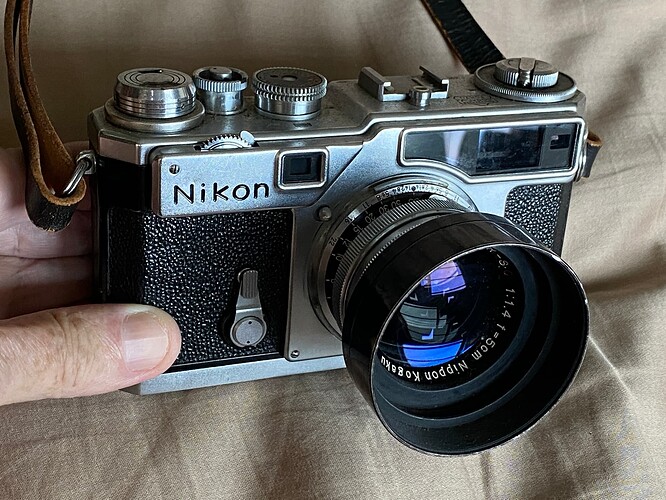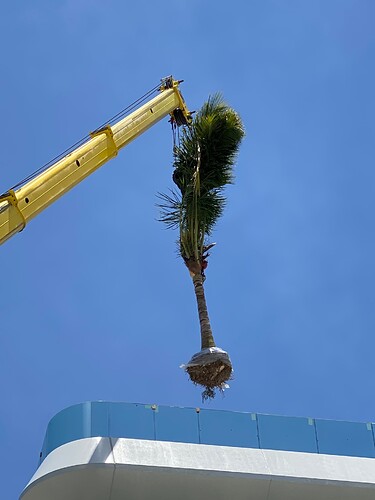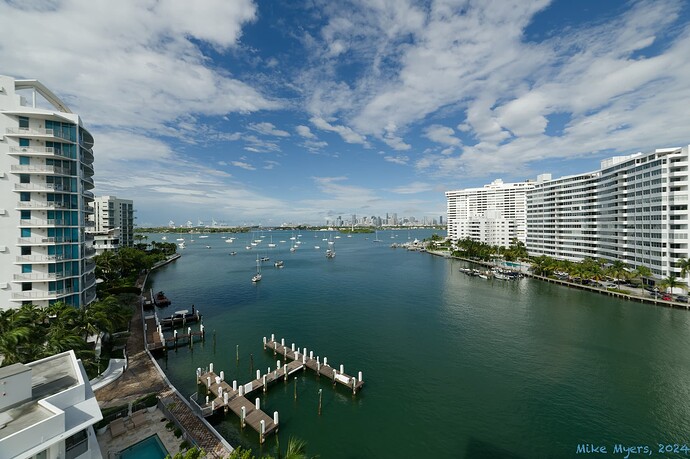I have never tried to convert a photo with a low focal length. If there are any crooked lines, I can straighten them with DxO, to a limited extent. If I take a photo with a fisheye, I want a fisheye photo and will not change the geometry. If I want a landscape photo, I use the landscape function of the camera, knowing full well that it doesn’t work with raw. If I want a landscape photo in high quality for post-processing, I take several raw photos in a horizontal line and use stitching software to stitch the individual photos together when the postprocessing is complete.
Are you selling images?
I was in a hurry. ISO 1000 with PhotoLab I think of as being like ISO 100, no noise, and I can use a high shutter speed in case my hands were not very steady. I don’t think you meant to write “16mm” as that was just the focal length of this lens. You can read all about the lens in the link I already posted to Ken Rockwell’s review. As to aperture, with a fisheye, I think of it as having almost infinite depth of field, but I focused on the fellow’s face, and would have been even happier with less depth of field. My camera had selected f/14, which I thought was fine. Shutter speed was still only 1/13th second - had I been thinking, I’d have bumped up the shutter speed, and maybe used only f/8 or so.
I guess I should add that I trust the exposure on the Nikon D780 - the camera was in (M)anual mode, and the exposure indicator in the viewfinder was centered. I really want to start using my other cameras again, but I’m spoiled of how I can trust this camera to do what I want.
Going way off topic - I used to carry this camera anyplace I went, at home, work, college, and with a few extra lenses I could use it for anything, even sports:
Lately I carry my D780 everywhere I go, but with Florida up near 100 degrees, I went shopping yesterday and left the camera at home. So of course, I found this, with no camera other than my iPhone 15 Pro:
People with $$$ don’t plant trees, they buy them full grown, and with a big crane, the trees can be “planted” on rooftops. Anyway, I had to get a photo, as otherwise nobody would believe this!
The D780 is my modern-day replacement for my Nikon SP. @Joanna is happy, but all the rest of my neglected camera gear is getting jealous, and angry at me!!!
Oh well, that’s more than I ever intended to post. Time to make breakfast. And one project for today is to find a source for the great fisheye conversion software that used to be readily available.
@Joanna, what software did you use? Something from Topaz?
I still want to find the old software, but I’m surprised you got something this good from what I posted. ![]()
Yet one more tool I don’t think I’ve ever tried. Will figure this out later today.
understood
Probably not.
Search attributes - year, location, people’s names, city, country, camera…
Curious - I disagree, and ought to have used a higher shutter speed, but for me, camera shake is always a concern. Agreed that at 16mm, camera shake is less of an issue, but to me it really IS still an issue, meaning I goofed, not realizing the full settings. Aperture should have been less, and shutter should have been higher. My mistake.
I sort of disagree, but I’ve got a drawer full of lenses. What camera are you using?
Thanks to @Joanna, my mode switch is super-glued to (M)anual, and the rest is up to me. The specialized functions that a camera can do (even the D780) I ignore. There are a dozen or so of them. To me, they are “toys”. I got dragged into using only the Manual setting, and the rest was up to me. Agreed, a tripod and capturing several photos, to be combined later in the computer, is a great way to do this - as long as everything is set up properly to begin with, as in the tripod being perfectly vertical. I used to use “stitching software”, but it’s been so long, I don’t remember which one. What do you use?
As for lenses, while I have the 16mm fisheye, I also spent far too much money and bought a Sigma 14mm f/2.8D Aspherical. Ultra wide angle, but rectilinear, no fisheye effect.
More info:
https://www.nikoncafe.com/threads/experience-with-14mm-f-2-8-sigma.118590/
Just a thought - it’s every bit as good as I expected, even more so.
Taken just now:
780_5746 | 2024-06-23.nef (28.2 MB)
780_5746 | 2024-06-23.nef.dop (13.1 KB)
No need to straighten vertical lines.
This post will be totally off-topic.
Something that has bothered me, is what to do with my old photos, that I want to be able to look through and maybe use every so often. I really do NOT want to set the whole thing up in Lightroom again, and since almost the entire collection is jpg images, not raw, maybe I shouldn’t use PhotoLab. Perhaps I’ll just edit those old jpg images in DarkTable. I stumbled upon this DarkTable video and it seems straight forward, and easy to use.
https://www.youtube.com/watch?v=xi4x2qQkG8c
This brings up my real question I have for this forum. I suspect many of us have been taking photos starting when we were little kids. Now we’ve all advanced to where we can call ourselves “photographers”. My question is what have each of you done, if anything, with your old collection of negatives, slides, jpg and digital images? Or, do you even care about them anymore? Or, like me, do you have folders with your old negatives, boxes of slides, and various digital and paper folders stored somewhere?
ALL my images including the digitized negatives are manged by the DAM I have choosen. (Imatch) . All operation I’m doing in DAM, except post processing. This , and just this, I ’ m doing in DxO. For layer processing I’m using Affinity. That’s it. The middle of my workflow is the DAM.
I digitized my slides and negatives, they exist peacefully together with files from my digital cameras, all on the same drive in my Mac.
Everything imported and cataloged in my DAM which is the hub of my workflow…
Old negatives (going way back to some glass plates that were my grandfather’s) are stored in far from ideal conditions in cardboard boxes. They are in a hopeless jumble. Sorting them out is a slow work in progress.
Slides that were my father’s are stored in far from ideal conditions but they are in proper boxes. They have had an initial cull, to keep only those featuring family. Sorting them out is a slow work in progress.
Slides that are mine are stored on a shelf in my study in proper boxes that are the most space efficient I could find. They are, sort of, indexed on paper. Re-indexing them in an Excel workbook is a slow work in progress. In my dreams the index will end up in a proper db. but for now it’s quick and easy to search the Excel workbook.
I have a 10TB data drive in my PC. I holds all my digital images, which exist as RAW+JPEG pairs and which are fully browsable and keyword searchable using Google Picasa (yes I know it’s ancient but it still works, even on Win 11). All the digital files are backed up to a separate external drive but I don’t keep that back up ‘off site’ so if my house goes up in smoke I’ll lose everything.
My question is what have each of you done, if anything, with your old collection of negatives, slides, jpg and digital images?
Slowly sorted, tossed or digitized both old family prints, slides, and movies going back 3-4 generations. Keyworded and organized by decade/year (folders) on triplicated SSDs (mine and children’s homes) as well as in the cloud. We kept some personal favorite originals for sentimental reasons. Oldest goes back to 1880s. Every year or so we add current photos. The cloud service is only shared with family (private).
Non-family hobby photos (travel, landscape, and nature) are kept on a collection of SSDs and the cloud. Also organized by keywords and decade/year folders. I stopped using LR a few years ago and rely on the search capabilities of my cloud service to find photos by keyword and basic metadata. These are mostly all jpg “output” and were “produced” to share with others.
I keep the raw photos on separate SSDs in a similar file structure. I’ve rarely re-edited an old photo so haven’t addressed if/how to archive. I am trying to be better at culling marginal photos to keep the collection manageable. This is still a “work-in-progress”.
Pretty much the same with some less used exceptions.
- I have one of my custom settings (on the camera’s top dial) set to ISO 200 (as low as Olympus goes) and image stabilisation off - my tripod mode.
- If I need a fast shutter speed, I’ll consider setting a higher ISO.
For panoramas etc, I use exposure lock.
When you stopped using Lightroom, I assume you kept (or moved) all your original images. Did you keep, or delete all the other data that Lightroom wants to store, including the “catalog”? Did you keep both the original images, and the finished images you created from within Lightroom?
Mike, just to clarify, you do know that your original images and the exported versions containing the edits you made in Lightroom are not actually stored in Lightroom, correct? If so why would you question whether someone would keep those images when they were no longer using Lightroom?
Mark
Mike. Original image files are not stored in any particular app, they are just stored on your hard disk in folder hierarchies, which an app references when it “imports” those images.
In fact, all apps like Lightroom do is to add the file locations to their own database and possibly create XMP sidecar files alongside the image files in their own locations.
Adobe likes to give the impression that Lightroom “takes ownership” of your files and that you can’t access them without keeping on paying out the monthly rental fee. This is deliberate to try and encourage the technically ignorant to keep on paying.
If you can see your files and folders in Finder, then that’s all you need for any other app to access them. Or you can move them to wherever you want. The only reason to continue to use Lightroom is if you want to do further work on images that you have already treated.
But, if you are not bothered about how you edited an image in Lr, you can simply open it in any other app, like PL and work on it from there.
As for files that were “exported”, that is up to you whether you want to save yourself re-processing them or start again from scratch.
The beauty of PL is that, as long as you keep the DOP sidecar files, you don’t need to keep exported copies, you can simply reopen the original file, select the appropriate virtual copy and re-export it again.
So you are confirming that the only thing I need to keep, is the original files. All the Lightroom files, including the catalogs, can be deleted. Yes, if I want to bring back one of those files, I will re-open it, most likely in PhotoLab, but perhaps in DarkTable. To answer your specific question, “start from scratch”.
For me, I’ve currently got 5 Apple computers (only two of which I will keep), and my Lenovo W530 Windows computer. Everything useful on the Lenovo was copied a long time ago to a folder on a Mac computer. I’ve also got some Windows laptops that haven’t been used in around 20 years or so. Most of my older photos are on the Lenovo, but I may or may not have some photos on the other laptops.


